
MAY CONTAIN NUTS

Search Shorpy
SHORPY ART

Framed or unframed, desk size to sofa size, printed by us in Arizona and Alabama since 2007. Explore now.
Join and Share
Ad-Free Shorpy
Shorpy is funded by you. Patreon contributors get an ad-free experience.
Learn more.

Recent comments
- Texas Flyer wanted
- Just a Year Too Soon
- WWII -- Replacing men with women at the railroad crossing.
- Yes, Icing
- You kids drive me nuts!
- NOT An Easy Job
- I wonder
- Just add window boxes
- Icing Platform?
- Indiana Harbor Belt abides
- Freezing haze
- Corrections (for those who care)
- C&NW at Nelson
- Fallen Flags
- A dangerous job made worse
- Water Stop
- Passenger trains have right of way over freights?
- Coal
- Never ceases to amaze me.
- Still chuggin' (in model form)
- Great shot
- Westerly Breeze
- For the men, a trapeze
- Tickled
- Sense of loneliness ...
- 2 cents
- Charm City
- What an Outrage
- Brighton Park
- Catenary Supports
Member Photos
The Shorpy
Print Emporium
Print Emporium
Search Shorpy
Search results -- 30 results per page
- Bevo 10 Cents: 1917
- ... by Anheuser Busch. Wikipedia link . - Dave]
That bike Amazing bike. HUGE bars, and check out the saddle. I would love to ride that thing ... Posted by Dave - 05/04/2018 - 11:32am -
![Bevo 10 Cents: 1917 March 15, 1917. Oklahoma City. Jack Ryan is 6-year-old newsie who lives at 126½ West Reno Street. View full size. Photograph by Lewis Wickes Hine.
Nice pattern matching...on the man's plaid cap!
BevoThat Bevo must have been some concoction to warrant a dime a bottle! Probably a quart bottle, though. After all, when I was a kid in the '50s, Cokes were still only a nickel.
[Bevo was a popular nonalcoholic malt beverage made by Anheuser Busch. Wikipedia link. - Dave]
That bikeAmazing bike. HUGE bars, and check out the saddle. I would love to ride that thing around town. I wonder if it's fixed or has a coaster brake.
(The Gallery, Bicycles, Eateries & Bars, Kids, Lewis Hine, OKC)](https://www.shorpy.com/files/images/04022u1.thumbnail.jpg)
- Law & Order: 1932
- ... $773 out of his own pocket for provisions."
The bike It appears to be a flathead, but I don't know what make it is. The ... The kick pedal kicks you back!
Harley Davidson The bike is a V series Harley Davidson, a 74 cubic inch flathead. 1932 was the ... Posted by Dave - 06/02/2014 - 7:00am -
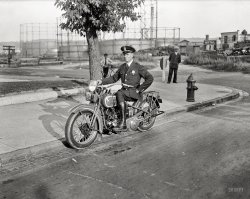
- Running Behind: 1963
- ... down Savoy model with a six cylinder engine.
A Cheap Bike Lock seems to have found a better use as a hood tie-down on this ... Posted by Dave - 07/18/2015 - 8:24pm -
![Running Behind: 1963 1963. "Cab driver and taxi at Saxony Bar & Lounge, Boston." 35mm negative, photographer unknown. Another eBay find scanned by Shorpy. View full size.
What's He Going For?Based on his near-full immersion, the gearshift linkage or the starter motor.
Poor man's power steering"Necker's knob" on the steering wheel.
1963Back then you could actually fix your own car.
Fancy TaxiThis was a top of the line 1956 Plymouth Belvedere before it became a cab. It even has the optional wire wheel hubcaps. Most taxi companies used a specially equipped stripped down Savoy model with a six cylinder engine.
A Cheap Bike Lockseems to have found a better use as a hood tie-down on this battered Belvedere.
[It's a hood lock now. - Dave]
My dad the cab driver.My dad drove a cab in Boston from 1962 to 1964 so you can imagine that this caught my eye. He was tall and slender so I don't think this is him. Unfortunately he passed away a year ago but oh boy....he would have LOVED this photo. Thanks.
Stick or AutomaticIf it's a stick I would guess he's trying to get the shift levers back in alignment.
Those old "three on the tree" shifters could get worn and jump in between the levers, leaving you stuck in one gear.
[With no shift lever to be seen here, the car had a PowerFlite automatic transmission controlled by pushbuttons on the dash. - Dave]
Park SquareThe Saxony Lounge was located in Park Square, which for many years was the location of the Greyhound/Trailways bus depot and home to a lot of sketchy activity (drug use, prostitution, street theft, you name it). More recent arrivals to Boston will know Park Square as it currently exists - the home of upscale restaurants, office buildings, and fancy hotels - it has undergone a massive transformation in the past 20 years. I don't think either the buildings or the street shown in this photo still exist. (The address of the Saxony was 35 Providence St. - although there is still a street with that name it's really no more than an alley. I think this portion of it was in an area that got reconfigured.)
That darned pushbutton PowerFliteWe had a 1957 Plymouth back in the day. After a visit to the dealer to replace the light bulb behind the buttons, it seems the panel was not properly secured. One good bump on the way home and - off comes the panel, and out pop the buttons? After a couple of tries, I figured which went where and off we went.
Havana-Where one would now need to go to see such a nice variety of late 1950s American autos in everyday urban service.
(The Gallery, Boston, Cars, Trucks, Buses, Found Photos)](https://www.shorpy.com/files/images/SHORPY-BW-009.thumbnail.jpg)
- North by Night: 1940
- ... breeze would be very humid, hot, and muggy.
That Bike Looks exactly like the one that my wife had a few years back. Her's ... Posted by Dave - 05/02/2021 - 3:03pm -
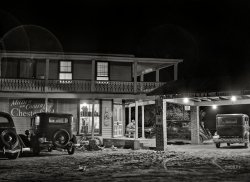
- Howard's Chicken Shack: 1943
- ... steering wheel is a '40, '39 would have a banjo wheel.
Bike Plate I remember getting a bike plate in Florida even in the 60's. We filled out a form and paid a few ... Posted by Dave - 07/03/2016 - 12:14pm -
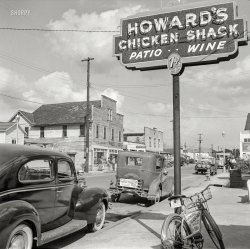
- Howard the Delivery Boy: 1913
- ... Lewis Wickes Hine. View full size.
Howard's Bike Man alive that bike is too tall for him! The fork looks to be bent also - in almost the same ... Posted by Dave - 08/13/2013 - 3:50pm -
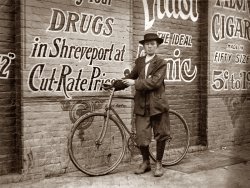
- Pedal Pusher: 1957
- ... 4x5 acetate negative. View full size.
Boys' bike We have a men's model that looks to be a few years older but has the ... tire classic.
That is my wife Not quite, but same bike, same clothes. Summer 1957. Twenty two years old.
St Elmo She's ... Posted by Dave - 07/31/2015 - 9:54am -
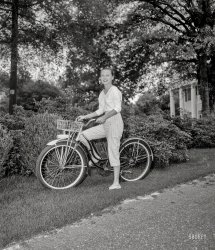
- Sidesaddle: 1929
- ... Sidesaddle will be face-down in the dirt.
My favorite bike! They used this inline four engine for aeroplanes also. I first ... Posted by Dave - 04/06/2013 - 12:44pm -
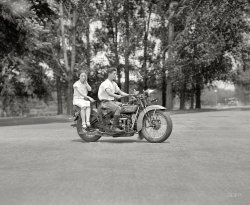
- Future Biker: 1935
- ... 35mm nitrate negative by Ben Shahn for the FSA.
Sweet bike West Virginia is great place to ride.
What a ride Hmmm ... 1930 ... Posted by Dave - 04/06/2013 - 11:49am -
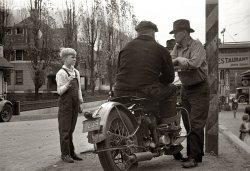
- Bill on Wheels: 1922
- ... assist in making a splint should you need either.
The bike Is an Indian single-cylinder flat track racer from sometime in the ... Posted by Dave - 08/22/2016 - 2:58pm -
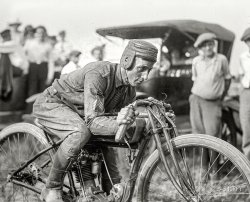
- Cycle Cops: 1918
- ... through the tulips than stopping snag ups in their bike chains.
I can only imagine what a modern day bike may look like, scabbard down the fork tubes for a long weapon, flashing ... Posted by Dave - 08/13/2013 - 3:34pm -
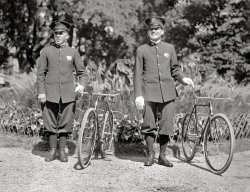
- Pale Rider: 1940
- ... almost looks like binoculars or glasses.
Interesting Bike Can't quite make out the make. The rather wide handlebars may not be ... Posted by Dave - 10/16/2018 - 3:01pm -
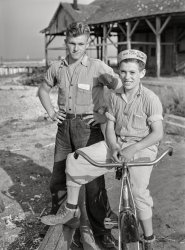
- Indian Curios: 1908
- ... rainy season. They just seem so out of place and time.
Bike parking Fascinating how they parked their bikes at this time, there seems like a short kickstand.
It also seems that bike theft was no huge concern.
(The Gallery, DPC, Horses, Stores & ... Posted by Dave - 05/23/2019 - 10:05am -
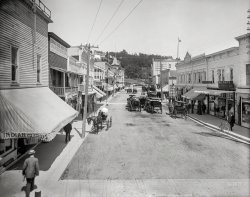
- Capitol Square: 1910
- ... native cavity nesting songbird population since.
Did bike locks exist back then? I wish we could leave our bikes at the curb ... Posted by Dave - 10/06/2020 - 11:34am -
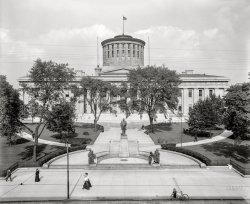
- Media Conglomerate: 1907
- ... Tesla Studios glass negative. View full size.
No bike? No problem -- just use your pony, like the kid in the back.
... Posted by Dave - 05/03/2014 - 3:03am -
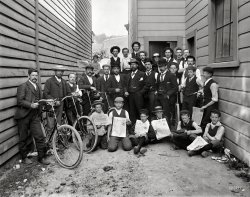
- Han Wah Laundry: 1901
- ... later the quieter pace of a quieter age is gone.
Bike & Camera Case Is that our photographer's bike and camera case in the lower right corner of the image? I would suspect a ... Posted by Dave - 10/08/2020 - 2:15pm -
![Han Wah Laundry: 1901 Washington, D.C., circa 1901. "View of Sixth Street N.W., west side, looking north from I Street." 5x7 inch glass negative, D.C. Street Survey Collection. View full size.
Tree wrapit looks like the trees are wrapped in chain link fencing.
Can anyone explain?
[Curbed horses tend to nibble. - Dave]
News ItemThe Washington Post -- Aug. 14, 1903
Han Wah Moy's Clothes Gone
Han Wah Moy, who conducts a laundry at 900 Sixth street northwest, failed to secure the door properly Wednesday night when he retired, and some one entered, carrying off the celestial's garments and a $5 bill which was in one of his pockets. Moy discovered the loss yesterday morning and, coming to police headquarters in borrowed clothes, reported the theft.
Still Going Strong!!This may be the first time that the D.C. Street Survey buildings shown are still here.
Re: News ItemFor a moment I thought stanton_square was back. (Note to new Shorpsters: this informative commenter, not seen for a few years now, provided relevant news items contemporaneous with the posted photo, in a distinctive format very similar to Dave’s comment.) I wonder where he / she got to.
Future shockThere are signs and portents here of the Han Wah Laundry's future: a disembodied foot and the faint ghostly images of passers-by; the blurred image of the woman hurrying away with a baby buggy; the abandoned bicycle; the shadow pattern on the pavement that calls to mind a devilish face. A century later the quieter pace of a quieter age is gone.
Bike & Camera CaseIs that our photographer's bike and camera case in the lower right corner of the image? I would suspect a tripod was also involved unless the camera was supported by some physical object like a wall etc.
[The case is for the photographer's glass negatives. - Dave]
(The Gallery, Bicycles, D.C., D.C. Street Survey, Stores & Markets)](https://www.shorpy.com/files/images/SHORPY-40305a.thumbnail.jpg)
- Rock and Roll: 1905
- ... that roll. 8x10 glass negative. View full size.
Bike tires Why are all the tires on the bikes and chairs a grey color? Was ... Posted by Dave - 01/07/2014 - 10:58am -
![Rock and Roll: 1905 Florida circa 1905. "Palm Beach Hotel." Offering various modes of transport, including chairs that rock and ones that roll. 8x10 glass negative. View full size.
Bike tiresWhy are all the tires on the bikes and chairs a grey color? Was that standard back then?
[Early tires did not have carbon black added to the rubber, which is naturally white. These have gotten dirty in use. -tterrace]
(The Gallery, Bicycles, Boats & Bridges, DPC, Florida)](https://www.shorpy.com/files/images/SHORPY_4a12553a.thumbnail.jpg)
- No Parking: 1906
- ... It's over by the curb to the right of the kid on the bike.
+102 (Memphis) Below is the same view (looking west on Madison ... some massive perception problems?
The kid on the bike Seems to be the only one who knows his picture is being taken.
... Posted by Dave - 08/14/2012 - 11:45am -
![No Parking: 1906 DON'T HITCH HERE, the signs say. But where is "here"? The year is circa 1906. 8x10 inch dry plate glass negative, Detroit Publishing Company. View full size. UPDATE: It took only 13 minutes for an astute Shorpster to give us not only the location (Madison Avenue in Memphis, Tennessee), but also a current photo.
"You go first"he said, as they headed for those precarious fire escape ladders.
"But where is here?"It's over by the curb to the right of the kid on the bike.
+102 (Memphis)Below is the same view (looking west on Madison Avenue from November 6 Street, Memphis) taken in August of 2008.
Post no billsI have to chuckle when I look at the telephone pole -- it is as covered with stuff back in 1906 as it would be today. And some of them look like the same stuff! I see that there is a wallpaper company in town as well.
Interestingly enough it looks like whatever crossbars that were supposed to be on the pole have either been removed or not installed yet.
[It's not a telephone pole. It's a support for streetcar wires. - Dave]
Then why the cutouts further up the pole ( the square notches) also this looks like it was not a refined piece of work. Note the "y" at the very top. This looks like a tree that was adapted as a pole... in somewhat of a hurry.
Midcentury New York street photographyI just discovered Shorpy today and I must say it's an incredible find.
My contribution comes on behalf of my Grandfather, Frank Oscar Larson. A little of a year ago my mother, while sifting through old boxes, came across a box of negatives taken by Frank in the 1950s. Frank was a banker by profession, but an avid photographer on the side. I've sorted, scanned and worked them into a website. I hope you find it interestind.
http://www.franklarsonphotos.com/index.htm
His work is now on display at The Perfect Exposure Gallery in Los Angeles.
Best, Soren Larson
[The photos are amazing! Shorpy says check them out. - Dave]
Comparison of then to nowOne thing that struck me was how much more life the old picture has then the new one? Of course this could be explained by circumstance like day of week, time of day etc. but that was my first strong impression. Nice photo, the first one.
Filled InHave they closed off the portion of the Madison building that dipped in or are my eyes having some massive perception problems?
The kid on the bikeSeems to be the only one who knows his picture is being taken.
Anybody want to buy a vowel?All the EEEs you need are in the four-story building on the right.
RuinedRe Soren's comment, it does generally seem to be the case that whenever we get a before and after here, the old photo has more life, at least in the streets, and outside of NYC. Beautiful photos he's brought us.
In regard to this pair in particular, one of the most striking things to me is how the tall building has been utterly ruined. That groove on the side was essential; with it gone, the building is no longer elegant but squat, and throwing that junk on the top adds to the insult. UGH!
[Darn fire codes. - Dave]
(The Gallery, DPC, Memphis)](https://www.shorpy.com/files/images/mancinis.thumbnail.jpg)
- Dime-Store Ghosts: 1919
- ... explained here . - Dave]
Early Harley Adventure bike? Now THAT looks like fun - looks like some type of HD - perhaps a model ... Posted by Dave - 10/21/2015 - 11:01pm -
![Dime-Store Ghosts: 1919 Washington, D.C., 1919. "McCrory's 5 and 10 Cent Store, Seventh Street N.W." National Photo Company Collection glass negative. View full size.
No Democracy HereThree (visible) "McCrorey's" vs. two "McCrory's". Only the Big Guy himself can straighten this one out.
Ghosts, indeedThis store was the scene of a horrific explosion a decade later.
Motor cycle, glass tile, ghost in windowBased on the shape of the gas tank, I'm thinking that's an Indian motorcycle with the side car. The square tiles between the store front and the sign were black glass. My wife and I did some remodeling to her store front years ago and found that the same black glass tile had been covered up by T11 siding years before. Would have liked to uncover it but too many pieces were broken and couldn't afford to replace them. Is there someone in last window on the right on the second floor?
Driving in snow during the 1910sDriving in snow must have been quite an adventure back then, I seriously doubt the tires could provide anywhere near the traction modern tires can. Not to mention the creature comforts of trying to keep warm.
+10 Previously On ShorpyThis store 10 years later was posted 2 years ago on Shorpy www.shorpy.com/node/15005. As noted in that posting, in 1929, the boiler in the basement exploded which demolished the first floor and killed six people.
[Also the place was gutted by fire on Feb. 13, 1912. - Dave]
Tall taillights and winter clothesTo light the kerosene tail light on Reisinger's Ford truck takes a tall person. Cars and trucks wore winter outfits, qv.
E-CommerceI sense a little ambivalence on Mr. McCrory's part regarding the family name -- was dropping the "e" a marketing move? And did it make him a renegade, or bring shame on the family? At least the cornice markings remain clear about the "McCrorey" legacy.
[It's all explained here. - Dave]
Early Harley Adventure bike?Now THAT looks like fun - looks like some type of HD - perhaps a model J with a sidecar and knobby tires. Sixty one cubes (1000 CC's) of fun.
Bar-B-Q jointThe Woolworth store mostly out of the shot on the left is still there, and now hosts a Hill Country Bar-B-Q. The Keppler Building, however, is gone. Replaced by a highrise with a China Chilcano restaurant on the ground floor.
HD Model JI do believe Rule 292 is correct on the identification. Must have been a hoot to ride in the snow.
+98Below is the same view from July of 2017.
(The Gallery, D.C., Motorcycles, Natl Photo, Stores & Markets)](https://www.shorpy.com/files/images/SHORPY-28515u1.thumbnail.jpg)
- Iowa City in the Snow: 1940
- ... winter day in Iowa. Also, what's that hanging from the bike's handlebars? Some kind of tail ornament? Cool!
Same block as the last ... Posted by Dave - 08/13/2013 - 3:35pm -
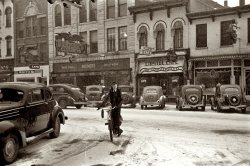
- American National: 1918
- ... look like that.
Sidewalk sidecar Check out the bike with the cargo sidecar in front of the bank! And what are those brass cans ... took it with him while he was shopping.
Motor Bike I'll be. It looks like a Smith Motor Wheel. They were usually mounted ... Posted by Dave - 08/23/2012 - 5:35pm -
![American National: 1918 Washington circa 1918. "American National Bank, F Street." Right next door to Harris & Ewing Photographers, who took so many of the photos (including this one) seen here on Shorpy. Harris & Ewing glass negative. View full size.
Still There?Please tell me this wonderful building is still there!
["This wonderful building is still there!" - Dave]
View Larger Map
Victor E. Desio & Co.
Desio & Co. will Remodel Dwelling
Victor E. Desio & Co. have plans prepared by Julius Wenig, architect, for remodeling the three-story and cellar store building at 1309 F street northwest. The entire building, which is 26 feet wide by 82 feet deep, will be remodeled into two stores. The front will be of all glass show windows, marble base and copper trimming. The second and third floors will be fitted out for store and work rooms, and an electric elevator will be installed from the first to third floor. Metal ceilings and marble floors will be a feature on the first floor.
When completed the work will represent an outlay of $8,000. Work will be started July 12, and Victor E. Desio & Co. will occupy the west store and Howard Deane the east store by September 1.
Washington Post, Jul 9, 1916
Victor E. Desio Rites Arranged Here Tomorrow
Victor E. Desio, retired jeweler, who for many years conducted business at 1309 F street Northwest, died yesterday at his home, 2400 Fort Scott Drive, Arlington, Va. He was 64 years old.
Born here, Mr. Desio carried on the jewelry business founded by his father, the late Gerome Desio, in 1874. He was a member of the Holy Name Society and the Lido Civic Club.
Washington Post, Jan 19, 1943
Not Entirely ThereThat wonderful steeple -- was this a cathedral of banking? -- is gone.
Motorized bicycleCheck out the motorized bicycle at the far right. The more recent Schwinn Heavy Duty or the Worksman bikes look like that.
Sidewalk sidecarCheck out the bike with the cargo sidecar in front of the bank! And what are those brass cans on the sidewalk?
[Fire extinguishers. - Dave]
Motor PlacementMotor is mounted on right front fork.
AKA Baltimore Sun Bldg.Originally built for the Baltimore Sun newspaper. Alternate Shorpy view in 1924.
Bank In Sun Building
American National Acquires F Street Structure
The American National Bank has bought the Baltimore Sun Building, the price it is understood, being between $210,000 and $225,000. The bank will remodel the interior of the building, and will take the entire two first floors for its bankroom, giving it one of the largest rooms, if not the largest in the city. The bank will move into its new building in September or October of the present year, the deed for the purchase of the big office building, one of the finest in the city, and one of the landmarks of F street, is consummated practically on the first birthday of the bank, its first year of existence having ended yesterday. The bank has been looking for a new location for some months, its present building on Fourteenth street not being large enough.
...
The building was the first of the "tall buildings" erected in Washington, and when it was built, about twenty years ago, it was the handsomest business buildings in the city. It cost for the actual construction about $340,000.
Washington Post, May 5, 1904
BicycleI see the bicycle, but having trouble locating the motor. Maybe he took it with him while he was shopping.
Motor BikeI'll be. It looks like a Smith Motor Wheel. They were usually mounted at the rear of the bike. I've never seen one up front. Just like the one that the lovey Ms. Young has on her Bug.
Dayton Motor BicycleThat's a very rare Dayton Motor Bicycle. The motor is indeed very similar to the Smith Motorwheel, but it was a version sold by the Davis Sewing Machine Company, makers of the Dayton brand at the time. The engine is in the middle of the front wheel. The patent is here.
(The Gallery, D.C., Harris + Ewing, Stores & Markets)](https://www.shorpy.com/files/images/13912a.thumbnail.jpg)
- The Flying Merkel: 1915
- ... of a $440 Ford model T Runabout.
Oh, to have that bike today! In a 2012 Las Vegas motorcycle auction, the top seller of the ... Posted by Dave - 01/09/2014 - 2:49pm -
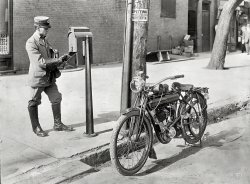
- Tyres & Fittings: 1910
- ... the sprocket turned. The usual result was falling off the bike. I hope they were sold separately.
Other BSA products BSA also made ... on the bikes. Still available. I have one on my road bike. Kinda hard on the tush until they get a little broken in, but then they ... Posted by Dave - 08/13/2013 - 3:30pm -
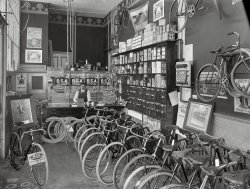
- The Pink Heap: 1957
- ... to the right of the ticket building, walk past some other bike shop until you get to the corner at South Beach. You walk to the right, ... Posted by Dave - 04/18/2023 - 5:55pm -
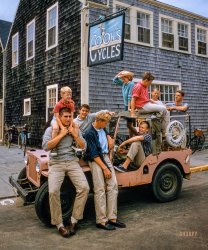
- Inaugural Umbrellas: 1901
- ... the same font for its masthead.
America's Choice Bike Shop Anyone have any idea what the name of the bike shop with the awning is? I would love to know if there was once a ... Posted by Dave - 09/13/2011 - 12:22pm -
![Inaugural Umbrellas: 1901 March 4, 1901. "President William McKinley second inaugural parade, Pennsylvania Avenue." Brady-Handy Collection glass negative. View full size.
Precision Umbrella Drill Team Rules!Complete with snappy white top hats (the Doo Dah Parade is calling, gentlemen!) And if that's The Washington Post building in the background, maybe they're the (well informed) destination for the impressive array of phone lines above the buildings on the left. Hopefully the men perched atop the other phone pole aren't disrupting calls!
Just funWhat a whimsical sight, from the umbrellas, to the white top hats, to the dog in the street. Can you think of any inaugural parade in the last fifty years that was as much fun?
Friends ForeverIs that a pickpocket in action left foreground?
MulletDid anyone else notice the fashion-forward hairdo on one member of the umbrella drill team?
Takes GutsThere are at least 2 men sitting on top of a telephone or light pole and a few more about halfway down. I hope they all got down safely.
DisneyesqueIt looks like it was staged by Walt Disney and great fun to be in and to watch. One of the aspects of "the good old days" that is actually true: no fears of disruption or calamity. A celebration of Liberty.
No dames allowed?Virtually no women visible in the ranks of the spectators. What's that about?
[There are dozens of women in this picture. - Dave]
What goes up must come... Wait, what?Again and again, we see photos on Shorpy that feature people fearlessly leaning out 6th-floor windows, cramming onto roofs, perched on mile-high balconies and swinging from the tops of fifty-foot poles. Makes me think the apple fell on Isaac Newton much later...say, the 1940s.
Pride ParadeThe umbrella corps would do San Francisco proud. Not that there's anything wrong with that.
Where's Waldo......can you find at least one man who is uncovered (not wearing a hat)? I think I can see a couple.
I find it heartening to see such enthusiasm for the workings of democracy. I suppose a cynic would say that it was a time when the people were starved for entertainment and would turn out for any dog and pony show, especially if given a few hours off. To me, in a time when the media weren't so pervasive, it was probably important that the democratic process was proved to have been completed.
A Prelude>> One of the aspects of 'the good old days' that is actually true: no fears of disruption or calamity.
That's a rather ironic statement considering that slightly less than 6 months later the man whose inauguration was being celebrated would lie dead in Buffalo, shot by the Anarchist Leon Czolgosz.
The VillageAnyone else see the umbrellas and capes and think of The Prisoner?
Short TermMcKinley, the last veteran of the American Civil War to be elected, would be assassinated six months later. His vice president, Theodore Roosevelt, would succeed him.
Number 2I thought of The Prisoner too.
Short Time in OfficeFrom the date of this photo, President McKinley would have but a little more than six months in office; losing his life to a madman's bullet on September 14th. His VP - Teddy Roosevelt would become the 26th President.
I agree that this looks to be a much more enjoyable inaugural parade than we've seen of late. I doubt that any of these marchers would be thrown out of their organization because they dared look at the President.
Social ProprietyOnce past the Umbrella Drill Team, one is impressed that onlookers are free to line buildings, windows and parapets. Although there is some police presence, it appears nobody really expects this important ceremony to be disrupted by protests or violence. No longer a safe assumption in these security-conscious days! Still, the price of this social stability seems to have been a rigid sense of "proper" dress and public decorum. One might wish to stroll down lovely Tremont Street in 1906 Boston, but imagine having to dress up like this just to go out! Those onlookers would be scandalized by at least 75 percent of today's ordinary public activities (Kids running around! Unsupervised teenage couples! Boisterous music!), not to mention our scandalously revealing comfortable clothing.
Mullet?I haven't been able to spot a mullet hairdo, but if JeffK is referring to the second umbrellist from the right in the first row, what looks like long hair in back is actually the bottom corner of the cape on the guy behind.
Ka Pow !Which one is the Penguin ?
Parade, si! Vote, no!I appreciate Stevie's comments on democratic spectacles. I feel that kind of nostalgia, too.
But before getting too carried away with that kind of enthusiasm, I would like to note that most of the spectators frozen in the year 1901 by this photo were unable to vote for either of the major presidential tickets (McKinley / Roosevelt or Bryan / Stevenson). Nor for that matter could they cast a ballots for Wooley, Debs, Barker, Maloney or any of the other presidential candidate who managed to get himself steamrolled by the Republicans in 1900.
Why? I assume that most of the people in the photo lived in DC. Any of them alive in 1964 would have been enfranchised by the 23rd Amendment (1961), and so could have voted for President in 1964--finally.
That's not to mention that no woman in the photo could have voted in 1900. The 19th Amendment wasn't ratified until 1920.
For that matter, it would have been unlikely that any of the African American males who were in town that day from Virginia or Maryland had been permitted to vote in their own districts.
So when we celebrate our democratic heritage, let's also remember how far we've come.
[Whether the women in this photo could vote depended on where they lived -- suffrage was granted by the individual states and territories (starting with Wyoming, in 1859) long before passage of the 19th Amendment in 1920. By 1917, women in 16 states plus Alaska already had the vote. - Dave]
(Dave, I appreciate your comments as well. I think I was looking at the forest, and you, at the trees. Just a couple things.
First, Wyoming was admitted to the Union in 1869, and its constitution did enfranchise women.
Second, a number of states did allow complete women's suffrage by 1915--not surprisingly, they were nearly all western states with Progressive traditions, save New York. (Differences from one state to another encouraged by our federal system must always be taken into account.) But in other states, even when they did enjoy the vote, the right to vote was not extended to women in all kinds of elections. This was the case in both Maryland and Virginia in 1901.
Third, there were localized instances of women being extended suffrage rights in the US before the Civil War, but those rights were very specialized. As I recall, in some states, women could vote if they were widowed and owned property above a certain value.
Finally, all African American males should have been enfranchsed after the passage of 15th Amendment in 1871. The odd thing is that, by and large, the women's suffrage movement of the 19th and 20th Centuries avoided taking black suffrage on board with their own cause.
Thanks again for both the entertainment you provide here, and the chance to blog about the occasional arcane, forgotten, or obscure issue.)
Dig that flag!Tthe flag in this photo is by far the coolest historical flag I think I've ever seen; I never realized that we went back, briefly, to the old circle constellation style for a brief period at the very beginning of the 20th century.
Dang! Never seen a flag like that!Parade flag with stars inside a circle of stars -- anyone know if or when that was an official flag?
Dressing up to go outOne might wish to stroll down lovely Tremont Street in 1906 Boston, but imagine having to dress up like this just to go out!
I once lived in a house built in the 1890s that had not had the privilege of being remodeled in the intervening century. Each closet was outfitted with precisely three hooks: One for Sunday, one for Monday through Saturday, and one for overalls.
Dressing up was surprisingly less onerous than you'd think when you owned precisely three suits of clothes. The smell, despite the presence of numerous laundries, was another issue entirely. Sweat, wool, tobacco, macassar oil, and lilac water is a powerful combination. Every time I see a Shorpy crowd photo from 1890-1910, the smell overwhelms me.
Suffrage in VirginiaArnnman writes about women's suffrage:
"But in other states, even when they did enjoy the vote, the right to vote was not extended to women in all kinds of elections. This was the case in both Maryland and Virginia in 1901."
I don't think this was the case in Virginia at all. Women here did not get the right to vote until three-fourths of the states ratified the Nineteenth Amendment in 1920. However, even then, Virginia refused to ratify until 1952.
Encyclopedia Virginia's entry on the subject can be found here:
http://staging.encyclopediavirginia.org/Woman_Suffrage_in_Virginia
If we got this history wrong, please let us know.
Washington Post buildingNear the middle of the photo you can see the top of the Washington Post building (located at 1339 E St. NW, according to the Post website). The Post still uses the same font for its masthead.
America's Choice Bike ShopAnyone have any idea what the name of the bike shop with the awning is? I would love to know if there was once a frame-builder in DC.
["America's Choice" was President McKinley. This was the R.M. Dobbins bike shop at 1425 Pennsylvania Avenue. - Dave]
The PrisonerThat was my first thought. Actually, I have thought about the show in a number of instances with the photos from this era. This one, though, was the one that REALLY did it for me.
Re: Never seen a flag like thatThere was no such thing as an "official" American flag until President Taft standardized the design in 1912. This flag design was as official as any other with the correct number of stars on it. It would appear to be the forerunner for Wayne Whipple's flag. See the pdf chart of US Flags at http://www.vexman.net/
(The Gallery, D.C., Politics)](https://www.shorpy.com/files/images/03416a.thumbnail.jpg)
- Lake Worth: 1908
- ... the trees on the left side of the walk.
Favorite Bike Trail When I lived in WPB I used to ride on the Lake Trail regularly. ... Posted by Dave - 08/13/2013 - 3:38pm -
![Lake Worth: 1908 Palm Beach, Florida, circa 1908. "Along the shore of Lake Worth." 8x10 inch dry plate glass negative, Detroit Publishing Company. View full size.
Whew!Having lived in Florida for a spell, I just can't imagine HOW they dealt with the heat having only fans and no A/C. Yet somehow they survived!
[Palm Beach, and Florida in general, was a winter resort. People didn't visit when it was hot. - Dave]
I realize that, I was speaking of life in Florida in general, year-round. It can get to 90 in January :)
ContrastsA straight shoreline and crooked trees.
Geography Palm Beach is a barrier island off the mainland from West Palm Beach. The body of water which separates West Palm Beach and Palm Beach is called Lake Worth; but it is really just part of the Intercoastal Waterway that runs down the length of the coast of Florida from Jacksonville to Miami.
Seems like each segment of the Intercoastal has been given a different name as it runs through different parts of the coast. For example: it's the Halifax River in Daytona Beach; Indian River down near Cape Canaveral; and eventually Biscayne Bay in Miami.
One assume the picture was taken on the grounds of the massive hotel in the background, but it's really hard to say which part of Lake Worth is pictured.
[You are no doubt thinking of the Intracoastal, not "Intercoastal," Waterway. - Dave]
Well, if you Google it, you find that both spelling are used to describe this passageway. I've always heard it called "Intercosstal."
[Google indeed reveals plenty of misspelled words. The waterway in question is the Intracoastal -- meaning along a single coast. Intercoastal would mean connecting two coasts. I was born in Miami and grew up in Florida, and so was well acquainted with the Intracoastal. - Dave]
Adult Perambulators
Farm Journal, November 1905.
No horses are allowed in Palm Beach, — only a lone mule pulling a light summer car along the famous palmetto avenue, from Jake to ocean, … The only other land conveyances are single and double bicycle chairs propelled by liveried colored men at a cost of $1 per hour. These can be seen going in every direction on the paved walks, the jungle trails, and over the long bridge across Lake Worth to West Palm Beach.
The American Scene, 1907,
by Henry James.
It is by means of a light perambulator, of "adult size," but constructed of wicker-work, and pendent from a bicycle propelled by a robust negro, that the jungle is thus visited; the bicycle follows the serpentine track, the secluded ranch is swiftly reached, the peaceful retirement of the cultivators multitudinously admired, the perambulator promptly re-entered, the darky restored to the saddle and his charge again to the hotel.
Waterway NamesThe reason for different names along the Intracoastal Waterway is that the different names were usually there first. The Waterway is a route - like a US Highway route on land, which might run over many roads with different names, but always the same route number. Many parts of the Waterway were originally separate bodies of water that have been linked by man-made canals and channels.
On a different note - why are the trees on the left side of the photo so twisted and the ones on the right side comparatively straighter?
"Intercosstal"As in "between the ribs"?
Landscape architectI think Dr. Seuss must have been in charge of tending the trees on the left side of the walk.
Favorite Bike TrailWhen I lived in WPB I used to ride on the Lake Trail regularly. This is a section of the South Trail with the Flagler mansion in the background.
Palm Beach Lake TrailThe Palm Beach Lake Trail has changed very little in the past 100 years. At the time of the photo the building in the background was the Henry Morrison Flagler home. Today it is the Flagler Museum. The Lake Trail runs some 6 miles almost to the Palm Beach Inlet and is only for pedestrians and bicycles.
(The Gallery, Bicycles, DPC, Florida)](https://www.shorpy.com/files/images/SHORPY_4a23623a.thumbnail.jpg)
- Over and Under: 1900
- ...
The car is clearly a C&NW car.
Upgrading a bike I noticed that the older boy has upscaled his bike to cool by flipping the handlebars over. Very racer looking.
(The ... Posted by Dave - 08/13/2013 - 3:44pm -
![Over and Under: 1900 Circa 1900. "Grade separation near Arlington, New Jersey." 8x10 inch dry plate glass negative, Detroit Publishing Company. View full size.
Transit SuperiorityTruly the two most romantic forms of travel man has ever created.
Classic 4-4-0That's about the most beautiful locomotive I've ever seen! They must have been burning special coal to have no visible smoke coming from the stack (bet it helped keep it clean too). By 1900, though, that classic layout was already considered obsolete.
You could probably see your reflection in the polished connecting rods and valve linkage.
Does anyone know what railroad this is? I can see lettering on the passenger car but can't quite read it even in HR. It isn't "PRR" (Pennsylvania, the one I remember from my NJ childhood).
[This is the Delaware, Lackawanna & Western locomotive seen earlier here. - Dave]
Two great looking wheelsand the cleanest steam locomotive on earth.
Howard Boulevard and Route 80I remember this from when I was a kid in the sixties. That's right by the back entrance to the Hercules powder plant. Today there is a park-and-ride.
Dressed to the ninesBoth the dapper looking youngsters and that gorgeous engine! The engine, quaint even by the standards of 1900, would look like it's going 100 MPH sitting still!
The GeneralA picture of the boys and their bikes would be interesting enough but this is an amazing picture. There's obviously something more interesting to look at than the camera or the train. The locomotive itself reminds me of Buster Keaton's "The General."
Road of AnthraciteThis is indeed the Delaware, Lackawanna and Western RR. The Lackawanna promoted its clean passenger service using "Hard coal, no cinders" with a creation of the ad guys known as Phoebe Snow.
A pretty lady was hired to be Miss Snow, and the campaign ran for many years before the Great War. A modern diesel powered streamliner placed in service after WWII was named "The Phoebe Snow" in honor of the original.
All of the fuss was about the DL&W burning lump anthracite, which didn't create cinders as soft coal did. The little American-type locomotive above has a long, narrow firebox [under the back end of the boiler and forward of the cab] which identifies the 128 as a lump burner.
These engines ran commuter trains from all over northern New Jersey to the Hoboken ferries at the turn of the last century. They had brief careers, however. They were replaced by larger engines that were demoted from mainline service by about 1910.
Hi-def look at the coach reveals a small "M&E" on the left end of the letterboard. This refers to the Morris and Essex Division. The coach also is lettered below the windows possibly indicating some sort of photographer's car.
[The car was the "Detroit Photographic Co. Special," which we'll be seeing more of, and whose progenitors carried DPC partner William Henry Jackson through Mexico and the American West in the 1880s and 1890s when he was exposing his "mammoth plates" -- 18x22 inch glass negatives taken by giant view cameras that were the Imax equivalent of the era, so massive they required a locomotive to haul around and develop. - Dave]
DPC SpecialThis special train was used by the Detroit Photographic Company to haul its photographers, equipment, and darkroom all over the country. The locomotives varied but the passenger car was specially fitted just for the company and as Dave noted, was owned by the Lackawanna. From what I understand, the DPC made at least two railroad excursion trips - one in 1899 and a second in 1902. Clearly they made other trips to gather photos that spanned several decades but the photo trains may have been more limited.
In quite a few other DPC photos you can see a locomotive pulling a single DPC passenger car somewhere in the distance. Before good roads and automobiles, the train was pretty much the only way to get anywhere that was more than a few miles away.
The photo below from the collection shows William Henry jackson sitting inside the DPC car.
Slick and sleekIt looks like this loco has been 'hot rodded'. Very slick indeed.
In three years that cycle on the left looks like it might have a Harley-Davidson motor slung into its frame.
Wonderful image, once again.
Dickson 4-4-0 Standard?
Railway and locomotive engineering, Vol. 8, 1895.
Equipment Notes
The Delaware, Lackawanna & Western have ordered two eight-wheel passenger engines from the Dickson Locomotive Works. They have received bids for 500 coal cars, and expect to award the contract this month. The road is very short of coal cars.
The pictured locomotive could be one of DL&W's Dickson Locomotive Works 4-4-0 Standard engines. Related photos on the web: here and here. The Lackawanna also owned several Dickson 4-4-0 Camelbacks but this photo is clearly not a camelback.
Straight skinny on the DL&W 128I had to go through my books and look this up.
The 19th century DL&W had the peculiar practice of having separate number series for each division.
Thus, our 128 was built by Dickson in 1876 with shop number 183, as DL&W Morris and Essex Div. no. 100 [During this period, she was named, logically enough, "Centennial"]. She weighed 87000 lbs in working order, and was renumbered in the general renumbering [1899, I think] to DL&W no.128. She was scrapped in 1909.
Detroit Photographic CarThe car may have changed depending on the railroad. The Denver Public Library has quite a collection of Detroit Photographic images as well, including these showing the car and a locomotive on the Chicago and North Western railroad.
http://digital.denverlibrary.org/u?/p15330coll21,8799
http://digital.denverlibrary.org/u?/p15330coll21,8796
The car is clearly a C&NW car.
Upgrading a bikeI noticed that the older boy has upscaled his bike to cool by flipping the handlebars over. Very racer looking.
(The Gallery, Bicycles, DPC, Kids, Railroads)](https://www.shorpy.com/files/images/4a07234a.thumbnail.jpg)
- Breaking Away: 1908
- ... Americans have been able to learn a lot about (and enjoy) bike endurance racing. But Armstrong's 17,370 career points in 17 years and ... very nice eHistory site, here’s a look at six-day bike racing by Ari de Wilde. Note that although he wrote “Strapped into ... Posted by Dave - 08/13/2013 - 4:32pm -
![Breaking Away: 1908 New York, December 1908. "Six-day bicycle race, Madison Square Garden." 8x10 glass negative, George Grantham Bain Collection. View full size.
At least three ridershave decided that motors on their bikes will make the six days fly by.
Spirits!Think we should call it the six day ghost-rider race !
Motorcycles!It appears that the is inaccurate. Looks like a motorcycle race to me. Looks closely at the bikes, they have tanks and motors. Then there is the advertising for motorcycles. Surely some crossover customers, but if there are bikes racing, they're not visible.
[This was a bicycle race. - Dave]
When does a bicycle become a motorcycle?Clearly, Indian was out in force for this contest. I wonder who won?
Can anyone make out what song was being sung? I'm guessing sheet music was a big thing at the time.
Edit: Thanks for letting me know that the motorcycles were for pacing the race. That clears things up.
Pacing the raceThe motorcycles are for starting / pacing the race.
The Madison SlingMy husband, who used to race track, tells me that there is a specific track race called the Madison Sling that is actually named after the Track Races they used to have at Madison Square Gardens.
I think it involves one partner recovering down near the center of the track while the other partner races a lap and then catches their partner and transfers their velocity to them and flings them into the track for their lap. He tried teaching it to me once with disastrous results (crashing hard).
Bottled Beer 20 centsYou could get 50 beers then for the price of one beer at MSG now!
Ghost RidersMaybe I should point out that the track is full of riders, who are moving too fast to show up in this time exposure.
Top Shelf20 cent whiskey! I'll take two please.
Judge fall down go Boom!If you look closely at the small tower with what could be the "Judge" for the race, the right hand leg of his chair is about 1/2" from going over through the railing.
Drink prices20c for a Beer, 10c for a Soft Drink!!
Apparently price gouging for refreshments at sporting events was common even back then!
This racing lives on!I think Dave is correct about the racers just being a blur. They'd do a complete lap in just over 10 seconds. You can see a couple of bikes on a tower on the infield.
Do a search on YouTube for 6-day madison race to see new and old footage.
Awesome poster.
There's a great DVD available too called "6-days in the Jazz Age".
Most people are amazed to hear what a huge sport it was back then.
Pedal of HonorThanks to the superb cyclists Greg Lemond and Lance Armstrong and TV, Americans have been able to learn a lot about (and enjoy) bike endurance racing. But Armstrong's 17,370 career points in 17 years and Lemond's 14,425 (14 years) are dwarfed by the record of the greatest rider of all time, Belgian Eddie Merckx, with 38,333 points in 14 years (1965-1978). He won nearly half of all the races he entered.
From Ohio State University’s very nice eHistory site, here’s a look at six-day bike racing by Ari de Wilde. Note that although he wrote “Strapped into single-speed bikes with no brakes, promoters could …”, he did not intend to say the promoters themselves were strapped into (not onto?) bikes, but the races would have been more noteworthy, much like Niagara Falls going the other way.
Shot and a shooter for 40 cents!Imagine what a fellow could do at the Garden that day with a four-dollar drinking budget! There'd be more than bicycles spinning.
Endurance Champions
The Evening World, December 5, 1908.
Old-timers on High Wheels
were Endurance Champions
During the running of the six-day bicycle race in the Garden next week, the question more likely to be heard than any other is whether those among the fifteen teams who can stand the gruelling pace in the test of the final days when stamina counts are not greater endurance than those who first brought this six-day record to America. The answer is furnished by a member of The Evening World's sporting staff who has witnessed nearly all the great six-day events in America from March 13 1886 when Albert Schock in Minneapolis hung up the worlds record of 1,008 miles for seventy-two hours-twelve hours a day-down to 1899 when Walter Miller and Dutch Waller set up a mark of 2,733 miles 4 laps in Madison Square Garden.
Conditions are vastly different to-day from those of 20 years ago. The modern bicycle, pneumatic tired and weighing only 22 pounds, is an air ship compared to the 50 pound high-wheeled boneshaker with its hard rubber tires and 57-Inch wheel. Then there is the difference of the scientifically banked track and the unbanked turns of twenty years ago, when a "header" meant almost certain death. Training methods have also changed, the six-day rider of today training almost exclusively for speed and under the team arrangement being relieved on the track at any time, while the old record holders were trained for endurance.
Speed has a deteriorating effect similar to the long steady grind, but when I think that Schlock never once left the tract in the first three day except to change wheels, and that his entire resting time was 40 minutes in the 72 hours it seems to be the most marvelous test of endurance I have ever seen-unless it be that of Mlle. Louise Armaindo, who beat Jack Prince in a 24-hour race because she never quit riding in the whole time. In the match race between Prince and Schock in Minneapolis, March 1886, when Prince set up a new world's record of 1,040 miles, neither man was off his wheel more than ten minutes for the entire 72 hours. This race, by the way, was for $1,000 a side, the largest side bet ever made in a similar contest in America.
The Outing Magazine, 1909
Bicycling and Its Income
James Moran, of Chelsea, Mass., who with [Floyd] McFarland won the six-day race at Madison Square Garden last winter, divided a purse of $1,500 together with outside sums paid by tire concerns and bicycle manufacturers amounting to in all nearly $5,000 with his team mate. This included bonuses from the management of the race. The six-day racers pay dearly for their money, however. The other leading teams in these heartbreaking contests draw from $800 down to $200 in prizes.
Round and round they go!Six-day races were, and still are, very exciting races. They consist of several types of races held over the course of six consecutive nights.
One type of race, the derny race, was held over a set number of laps while each rider is paced by a derny (motorcycle). These dernys can be recognized by their rollers behind the rear wheels that allow the cyclists to pace as closely as possible. Two can be seen in the photo.
Another is the Madison, named for Madison Square Gardens, that involves several two person teams. One teammate races along the lower, inner lanes of the track while the other teammate recovers up near the wall (outer rail). The teammates will exchange places every few laps and will do so with a handsling. During an exchange, the rider going into the race will drop down the track and place his left hand near his hip. The exiting rider will grab his hand and sling him forward, thereby transferring his forward momentum to the other rider. Doing so correctly takes a lot of practice. After several tries, and several failures, I decided Madisons were not for me. I'd stay with match sprints, points races, and miss & outs as they were less dangerous - or so I thought.
BTW, one way to tell there is a race in progress - of the spectators whose bodies are in focus, their heads are blurry from following the racers.
Cycling through time I used to race for the Century Road Club Assn., in 1950's New York. We were reputedly the oldest bicycle racing club in America, and I remember examining the scores of trophies from the late 1800's and early 1900's. I'm sure some of them must have been from races such as these. I still have scars from pile-ups of several single speed, trap pedal bikes, you just couldn't get your feet down to stop a spill.
Nobody saw the signIn the middle of the track is a sign showing songs presented by Cohan & Harris. That is George M. Cohan and Sam Harris. Cohan was a actor & songwriter in the Tin Pan Alley days and eventually became known as "the man who owned Broadway." James Cagney portrayed him in the movie "Yankee Doodle Dandy."
(The Gallery, Bicycles, G.G. Bain, Motorcycles, NYC, Sports)](https://www.shorpy.com/files/images/SHORPY_01532u.thumbnail.jpg)
- Playtime: 1943
- ... Additionally, I knew my neighbors and was allowed to bike all over the town. Now I live in an urban center where I still walk to ... Posted by Dave - 06/09/2018 - 7:43pm -
![Playtime: 1943 October 1943. Washington, D.C. "Boys watching the Woodrow Wilson high school cadets." Photo by Esther Bubley, Office of War Information. View full size.
Saturday Morning SpecialEven before the war, this was the Junior G-Man generation. The pistol packing boy might be aiming a realistic cast metal cap pistol, not all of which looked like western six-guns. Here's a 1940s magazine ad for a similar toy pistol, the popular "G-Boy" model.
Cap gunI had a hand-me-down cap gun in the 60s that was a baby .45. Wasn't as cool as the cowboy guns, so I am sure than it ended up in the bottom of a toy box and was "recycled" at a garage sale.
Cocktail HourPersonally, I prefer my Bubbly with a dash of Alibet.
Cap GunThe pistol the boy appears to be holding resembles a 1940 Kilgore Cap pistol, made of iron. Likely it was one of the police or police chief versions.
Reminds me of my childhoodDespite my mom's anti-toy gun stance (peace, love, against the Vietnam war, etc.), my brother and I had an arsenal of cap guns as kids. We blasted away whenever she was not around. Despite all this simulated childhood violence, we both grew up to be fairly normal adults who do not own any real guns.
Cap gunsMy parents were non-militaristic types; my father (reluctantly) got involved in WW2 as a RAF pilot, but his Quaker father had been jailed as a conchie in WW1 and he was never keen on guns. Nonetheless, we kids were cheerfully allowed to have and play with toy guns in the 60s - mostly games based on High Chaparral and Lost in Space and suchlike rather than war and soldiering, as it happens (well, there was The Rat Patrol). And pointing a toy gun at my brother (see pic, if it uploads OK) didn't seem to cause anyone to get worried (neither of us has ever had anything to do with real guns).
Some British schools have cadet forces, as per the film If... and also the Doctor Who story set in 1913 (Human Nature).
Is it really that different?When I was a kid, toy guns were my favorite. And yet my Dad would have tanned my hide had he caught me actually pointing a toy gun at another person. I was taught you just didn't point guns at people.
And I realize that the kid in this photo is not pointing his gun at the other boy.
But my kids grew up in a society where it was completely proper to point guns at other people and pull the trigger -- but they called it laser tag or paintball. You can also get into the whole video game mindset as well. Of course, you can't do it on your own, but at an arcade, or in the case of paint-balls, with expensive gear.
The difference I see is that by the time I was 12 or so, such games were not so interesting. The current generation is still involved in these games into their 20s and 30s.
ContextYeah, this might be disturbing to some people, but let's not forget the international context at the time. 1943 saw the height of World War II, and all the kids were immerese in the ambience of a "nation at war": bombarded with all those news reels in the movies, watching the cartels, and seeing mom worry about the absent parent / brother / uncle who was serving overseas. Many a kid witnessed the arrival of the dreaded letter to his / her parents; "Dear Mrs... I am terribly sorry to inform you..."
So, with old photos as with history, one can't merely judge them by comparing them with our own prejudices and standars. We must take in account the circumstances and the particular period where they were created. I'm sure that, back then, a scene like this was not as disturbing as we might find it today. Guess it is what OTY said, that children were accountable for being good citizens at all times.
That is really disturbingIt looks too much like that very famous Vietnam-era photo of a man being executed on the street.
InterestingThere are a couple of interesting things in this photograph...
Most obviously, it looks like the little boy on the left is aiming the gun at the other boy's head...but once you really look at it, the boy on the right is a few feet further away. (WHEW!) His stance though, makes it look like they are playing a very creepy "game".
The other interesting thing is...High School Cadet Team?? Forming up and shouldering rifles??? Can you even imagine that in 2009? Ah, the good ol' days...
Deja NamReminds me of the famous Vietnam era photo of an execution.
As Jack Nicholson Would Say...Hey, kid? You ever dance with the devil in the pale moonlight?
Hm.There's an unfortunate juxtaposition.
Imagine this scene todayThe boy pointing (what I assume is a) toy gun would be under arrest facing years of psychoanalysis. The parents of his "target" would already be on the telephone to their attorney looking to sue the boy as well as Woodrow Wilson HS, its principal and head of its cadet program not to mention the young man leaning on the soccer post for not intervening in what clearly is an act of bullying. The school spokesperson, since he hadn't seen the paperwork, would not be able to comment other than to reiterate that WWHS has a zero tolerance policy toward weaponry and that, once the truth comes out, they will be completely exonerated.
Not what it seemsAt first glance it looks like the boy in the middle is pointing that gun straight at the forehead of the other boy - but he's not, is he? He's nearer the camera by a yard or so, and pointing directly to the right.
Whatever, great photo.
Nothing much changes hereI live several blocks away from Wilson HS, and aside from the fact that they obviously no longer drill there in military uniforms, there is the occasional gunplay every so often. It seems that about every three years there is a shootout ... and this is the public HS in the city's safest and most affluent area!
Notable alums of Wilson HS include Warren Buffett, Frank Rich, and Lewis Black.
Armchair Psychologist's Field DayTo call this photo provocative is an understatement. The curious fact though is that this generation, currently referred to as "the silent generation" seems to have been the most peaceful, law-abiding, responsible, conscientious, peaceful and congenial group of decent and agreeable adults in recent memory. Yes, I am one. Yes, as kids we all had toy guns and we played "jack-knife" wherein we threw our pocket knives into targets drawn in the dirt. Yes, we used dagger-sharp geometric compasses in grade school without hurting anyone, and walked miles to school, often alone. Yes, we were just before the "Rebels without a cause" gangs, loved our families, enjoyed our cars, had fun dates, served our country, sewed our wild oats and then settled down to work hard, support loved ones and try to raise healthy, happy families. I do not have crime statistics to back this up, but from personal experience all the "playing" we did for the first 15 years of our lives with potential toy weapons did NOT make us violent or eager to hurt anyone. On the contrary, we are a bunch of very helpful, charitable, POLITE, simple, proper seniors now who walk at the mall daily in friendly groups and still love America. The preceding is strictly my personal opinion but I know hundreds of us from this era and there is not a bad apple in the bunch. Although this picture is reminiscent of the horrible famous photo from Viet Nam, I have no acquaintances who became violent criminals from playing with TOY guns. The difference is, I believe, that we had sensible,selfless, caring and sometimes strict parents and we ALWAYS had to be accountable for not behaving as the civilized people they expected us to be. Sorry to be preachy but I really fear that society is "de-evolving" and returning to savagery and barbaric behavior. The little guy in the chin strap hat who is resignedly acceptiing his fate like a man looks exactly like a neighbor I grew up with who became a soldier.
DrilledIn response to the "High School Cadet Team" comment: Ever heard of ROTC? I went to a college in the South (graduated 2003) and it was common to see ROTC members performing drills in the quad.
High School Cadet TeamDon't you know there's a war on? In 1943 there was and most of the boys in that group would be in it soon after they graduated from high school. A little early drill couldn't hurt, even if they did have to unlearn just about everything they picked up here.
Cadet RiflesHigh Schools still have rifle teams today, if they have JROTC unit.
Official Site https://www.usarmyjrotc.com/jrotc/dt
Wiki http://en.wikipedia.org/wiki/Junior_Reserve_Officers'_Training_Corps
- Proud Former JROTC Cadet, who shouldered his own (demilitarized) M1903 Springfield for drill... 15 count manual.. Arms!
Soccer '43??I doubt that there were any soccer goals at WWHS in '43, I think those are monkey bars.
Boys learning 2nd Amendment rightsThis photo could only come out of the USA. The only country on the planet that enshrines guns in their national Constitution.
Johnny Has His GunHeh, funny, Exercising his 2nd Amendment.
Can anyone tell if that's a real pistol or just an extremely realistic toy? It sure looks heavy and solid from here. I have a cap pistol from the '40s or '50s, and it's nowhere nearly as detailed as that (although it's a revolver, not an automatic).
Re: Boys learning 2nd Amendment rightsAnd yet we've got people from all over the world that still strive to become American now don't we?
In defense of my generation...I think it's a bit extreme to say that "the silent generation" was composed of better or more decent people than gens x, y, whatever, or that people in the past loved their families more, worked harder, or were better Americans than my peers and I. Actually, it's straight up offensive. A lot of criminals were born in the 30's and 40's, too. As were a lot of rude people, some of whom now apparently consider themselves "POLITE, simple, proper seniors." This is a really neat picture, though. I love the kid leaning on the monkey bars.
Small ArmsThe gun is a toy .45 caliber semi-automatic. You can tell because it not only lacks the hammer and sight, but a real .45 is over 6 inches long. The one in the picture looks much smaller. And a real .45 very heavy. My Dad taught me to shoot a .45 when I was about ten years old and it took both hands to hold it up straight!
Esther Bubbly FansFor those of us that are fans of Esther Bubbly and all the other wonderful photographers being shown on Shorpy, you can find many other photographs at the National Archives. Alibet, these photographs have not been edited as those shown here, they are still outstanding. The URL below will take you to an index of photographers. Don't overlook the 'Search' link also on the page. A wonderful place to visit.
http://lcweb2.loc.gov/ammem/fsahtml/fsaauthindex1.html
[Nothing like a little Bubbly to start the day, I say. - Dave]
Reply to "In Defense of..."I believe you failed to comprehend my message because I NEVER said anything about being "better than..." or "working harder" or "loving more". My point was only to state that playing with guns, knives and potentially deadly weapons did not make us violent misfits as some people claim it does. Why would I offend my own children and descendants by claiming "we were better" but I believe that is your personal interpretation of what was written, NOT what was actually written. I am very sorry if anyone was offended.
Boys and gunsLet's see. I grew up watching Gunsmoke and the Lone Ranger. Parents bought me a Daisy Red Ryder for my birthday. Played Cowboys and Indians and S.W.A.T. was never called. Grew up to be a productive law abiding citizen despite the "evil" toys. Imagine that.
YikesWell, that gave me chills.
The Way I See ItThe kid with the gun is aiming at some "enemy" in the distance. The smaller kid is imitating the drill team members.
I hate guns now, but I played "Army" and cowboys and Indians with them all the time during the early 50's. Once, after watching Gene Autry on TV, I conked a kid over the head with a piece of wood and was amazed when he didn't fall over unconscious. Shortly thereafter I was amazed when I couldn't watch TV for a week.
Grateful for the opportunityDespite years of studying (and producing) photography and film, I only learned of Esther Bubley after I became a regular visitor to Shorpy (perhaps Shorpy addict is more accurate). I'm a big fan of historic, journalistic, and modern photography -- even worked in an archive -- but I didn't know of Esther Bubley, and I think her work is wonderful. Her work fascinates me -- composition, subjects, content, emotional impact -- I thank you for posting her photos.
You people are S-L-O-WHe is not pointing the cap gun at the other child's head. The other child is standing behind him. Look where the feet of the children are. Come on now, think for yourselves.
[Talk about slow -- read the other comments. Carefully. - Dave]
Re: You people are S-L-O-WI really hate to appear to be S-L-O-W, but what is the significance of the quarter?
[It's a gift bestowed upon especially clueless commenters. So that they can go get a clue. - Dave]
Target practiceWhenever I see a scene of soldiers practicing their marching in formation, I wonder "how many battles ever got won because they were good at marching in formation?"
Has there ever been an enemy overcome by straight lines and precision steps?
In movies, the guys in formation are always the ones getting mowed down by cannons or snipers.
I'm reminded of a comment by one of the Kaiser's generals complaining that he seemed to think marching practice was all there was to war preparation.
Just some thoughts on OTY's comment...>> Sorry to be preachy but I really fear that society is "de-evolving" and returning to savagery and barbaric behavior.
Hey now OTY, the kids are OK. I don't know if you'll read this comment but I had to weigh in. As one of the early Millennials (aka Cold-Y or Boomerang Generation) let me reassure you. My parents were in the Silent Generation. I walked to school and used a sharp compass. Additionally, I knew my neighbors and was allowed to bike all over the town. Now I live in an urban center where I still walk to work. I still know my neighbors and make casseroles when people find themselves in a tough spot. The Millennials also manage to have fun even though the recession is weighing heavily on us. The Boomers won't retire and Millennials can't find work. We also give back to our community, are hard-working, and increasingly thrifty having learned from our grandparents the importance of putting away for a rainy day.
Taking your anecdotal example, I know hundreds of Millennials who, to a person, are not "bad apples." Even though the kids born today can seem alien, ("O rly? LOL, que! Srsly, wtf is w/n00bs. We pwnd them. 1337.") The Atlantic recently suggested otherwise. I tend to agree. You raised us right, stop worrying, we'll take our place and save the world when you let us. And our kids and grandkids will be awesome too.
So...
The kids are alright.
Neither demons nor angelsThe kids in the pictured generation weren't horrible animals because they played with guns, but come on, let's not pretend they were perfect and everything was wonderful back then and everyone today is inferior.
For example, look at the trash scattered on the parade ground.
My GenerationInteresting photo... posted no doubt for its shock value.
As a member of that generation, I played cowboys, space explorer, knight, soldier, etc. All the boys did (well, except for the odd ones who played with dolls ;-) Know what? We never once confused play with real life. Of course, physical violence wasn't graphic back then, nor was it performed with mind-numbing repetition, as in the slash movies or video games, for example. We also didn't take drugs or do a lot of other things kids do today.
Was it a better time to grow up? Damn straight it was.
Bubley whimsyDon't you think the photographer was intentionally having fun messing with the viewer's perspective to create that illusion? I do.
(The Gallery, Bizarre, D.C., Esther Bubley, Kids, WW2)](https://www.shorpy.com/files/images/8d41305u.thumbnail.jpg)
- Boomers, First Grade: 1953
- ... time. You had to be careful not to get them caught in the bike chain.
(ShorpyBlog, Member Gallery, tterrapix) ... Posted by tterrace - 03/04/2023 - 8:07pm -
![Boomers, First Grade: 1953 It's seventy years ago in Idyllic Larkspur™, where we find me (bottom left corner) with Bob, David, Bob, Jim, Jim, Margaret, Sandy, Donna, Rae Ann, Roberta, Virginia, Jerry, Buzzy, Fred, Gordy, Frances, Alice, Alice, Sheila, Mrs. Madeline Drew and others whose names I forget. This was taken within a month of losing nearly half our classmates, they having been siphoned off to the district's brand new school in neighboring "Twin City," almost-as-Idyllic Corte Madera. And that one was already overcrowded, for which first-wave baby boomers such as we must shoulder the blame. As for me, good old L-CM was just four blocks from our home at 9 Arch Street, and I continued to walk the round-trip every school day, rain or shine, until I graduated 8th grade. View full size.
I went to that school in about 1955I had the same teacher as the picture. Loved playing around the old electric railroad line long gone and the arch bridge behind the school. Saturday kids show at the Lark Theater or hit the dime store to buy a airplane model. Before that went to Park School in Mill Valley. Great times in Marin. Thanks for posting this. Don
Stripes and PlaidsI was also in Grade 1 in 1953, tterrace, so we must be close in age. It looks like the mothers of some of the girls had them wear their best dresses. You can check out my story in this Shorpy photo.
It was a great time to be a kidFirst -- I love all the missing teeth. In my memory I was snaggletooth for a year. Second -- Buzzy is a cool name. But in time it will work against him as the name on your ID has to exactly match the name on your ticket. I don't go by my first name and ended up having to put my full name on everything.
I've mentioned before when I was in second grade my family moved into a neighborhood with better proximity to schools. The neighborhood was built for getting kids through public schools. We easily walked to elementary, junior high, and high school. Now I see cars lined up a block long of parents dropping their kids off or picking them up and wonder how parents find the time and whether the world between home and school is really that much more dangerous.
I also remember my friends and I would go off riding our bikes for hours; our mothers had no idea where we were. No one thought we had bad mothers. I'm grateful we were given the opportunity to go explore our world as much as we wanted ... as long as we were home by dinner.
Let's play "I Spy"There's so much to choose from:
--at least 12 wearing plaid
--at least 6 teeth are missing
--one pair Converse high tops
--one puppy-love couple (though one party may be cheating)
--5 hair ribbons
I love this photo so much. When I headed off to kindergarten in 1958 I had the requisite plaid dress, pigtails, ribbons and saddle shoes.
Angus J WindsorAngus you and your mom look like the family that left for Australia in 1958. That photo was in Hawaii on your long journey south. Did you ever come back to Canada? I was a little older than you in St. Thomas Ontario 100 miles to the east.
Class SizeOne of my old classmates recently sent out via the internet the 6th grade graduation day photo from Loring Grade School in Minneapolis, dated June 1958. There were 38 of us in the photo, and three were absent that day. That was one of two 6th grade classes, the other being of similar size. How did the teachers manage it? I never thought about it at the time -- it was just boomer normality.
Bespectacled I hope that being (evidently) the only student in the class requiring corrective eyewear wasn't a significant peer-teasing issue for you. Kids can be cruel creatures, often because of their honesty to emotion and selfishness rather than sheer meanness. This reality however, doesn’t make learning the lesson that life isn’t a walk in the park where everyone gets along any easier. As the years continue to pile-on, my first day at school, Sept. 5, 1950, doesn't seem that long ago!
[Well, later on some of my classmates liked calling me "Professor," because of my glasses but apparently also - I later learned at a high school reunion - regard for my embryonic erudition. Which regrettably wasn't reflected on my report cards. -tterrace]
Say Che-e-e-seThis is the cutest picture. An abundance of genuine joy in their faces, few faked/forced grins in the bunch. Wish I had even one of my elementary-school class group photos.
I wonder if the couple standing in the back, holding hands, are brother and sister -- fraternal twins. They have similar facial features.
[No, Gordy and Frances weren't related. -tterrace]
2nd GenerationSons and daughters of the Western Electric Christmas Party.
[These would be their grandchildren! - Dave]
Zipper43 St. ThomasTop marks for making the connection Zipper 43. My father worked for Ford and introduced the Ford Falcon to Australia. Our family lived in Geelong and Melbourne from 1958 until 1963 when we moved back to Windsor. Two years later my father left Ford and the family moved to Vancouver, B.C. where I still live. In 1967 another job took the family to Winnipeg and finally Toronto. I was a trolley bus driver in Vancouver for 41 years and retired thirteen years ago. I have been back to visit Australia seven times.
Dress code?I see jeans, sneakers, and T-shirts. I started first grade in 1959 and we weren't allowed to wear those until 1969, when I was in high school.
Names on the backMy mom made sure we wrote the names of all the kids on the back of our class photos. Of course, we thought that was pretty silly, as we *knew* all their names. I should probably annotate the online pictures with text names in case any of those guys search the Internet for themselves.
It's fun to read those names. So familiar, when reminded. We moved away in the 6th grade, so all are scattered to the wind.
[There are names on the back in my mother's handwriting, but not for all, and with one "?". Interestingly, the blanks are the ones I can't remember now. Everybody else's I've never forgotten. -tterrace]
No suits and ties for kids in CaliforniaRe casual clothes -- California! I'm of similar age and also from Northern California and I have school photos of me in a white T-shirt. Don't have a class photos handy, so not sure if I was dressed up in those. At that age I was also wearing button up shirts my mother made.
Although I do remember in our Sacramento high school in the early sixties we were finally allow to wear shorts. As long as we had on long socks. I think that was a nonstarter; the long socks were not cool (in either sense).
Boomers, Kindergarten: 1953Here's my Kindergarten class picture, also from 1953, at Thomas M. Balliet Elementary School, Springfield, MA. The discolorations result from the fact that this was originally stuck into a plaster backing that we each decorated to give to our parents. My mother ended up cutting the edges to free the picture from its ugly 'frame.' I only remember two of the kids in the class. (I long since left Springfield and have spent my entire adult life in tterrace's area, the Twin Cities of Larkspur and Corte Madera.)
Rolled up pant legsNot sure how they felt about it at the time, but if it were acceptable these days to have my jeans legs rolled up as much as those guys in the front row, I'd be grateful, not because I'm soon going to experience a growth spurt like them, but because manufacturers don't make 'em short enough for me. I can vaguely remember those huge cuffs around that time. You had to be careful not to get them caught in the bike chain.
(ShorpyBlog, Member Gallery, tterrapix)](https://www.shorpy.com/files/images/SHORPY2132_0.thumbnail.jpg)























